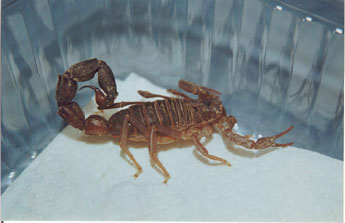Parabuthus granulatus
Ehrenberg,
1831
|
|

|
|
Common names:
Granulated Thick-Tailed Scorpion
Distribution:
Africa (Angola, Botswana, Namibia, South-Africa, Zimbabwe).
Habitat:
One of the larger species of Parabuthus, P. granulatus is found mainly in
dry habitats (receiving less than 600 mm of rain per year) in South Africa
and Namibia. It digs a shallow burrow at the base of shrubs in sandy to
consolidated sandy soils, but is also known to dig a shallow scrape under
rocks in soil of widely variable hardness and texture. It may also be found
in and around human dwellings in these areas.
Venom:
Parabuthus granulatus is the most medically important venomous scorpion in
South Africa, with potentially life-threatening venom (Newlands, 1974;
Müller, 1992).
In one study, 42 serious cases was reported with 4 fatal
outcomes. All fatal outcomes were children, which had not
recceived antivenom (made from P. traansvalicus
venom). The use of antivenom for serious cases is
reccomended.
A study (ses internet link below) reports of a LD50
value of 1.56 mg/kg for this species (other Parabuthus
species in South Africa had LD 50 values in excess of 20
mg/kg.
This species can not squirt venom.
Both studies conclude that P. granulatus is
the most important venomous scorpion in South Africa.
Selected litterature:
Newlands, G. (1974). The venom-squirting ability of Parabuthus
scorpions (Arachnida:Buthidae). South African Journal of
Medical Sciences 39: 175-178.
Lamoral, B. H. (1979). The scorpions of Namibia
(Arachnida: Scorpionida). Ann. Natal Mus., 23(3),
497-784.
Müller, G. J. (1992). Scorpionism in South Africa. South
African Medical Journal, 83: 405-411.
On the Internet:
Medical
importance of Parabuths granulatus confirmed by
LD50 studies.
Gifttier
Informationsdienst on Parabuthus spp.
General:
This species is probably found in some pet collections.
This species should only be kept by researchers or very
experienced keepers.
This is one of the larger species of Parabuthus.
Parabuthus granulatus photo by
Dave Gaban (C)
Part of the information about this species was supplied by Peter Croeser, South Africa
|